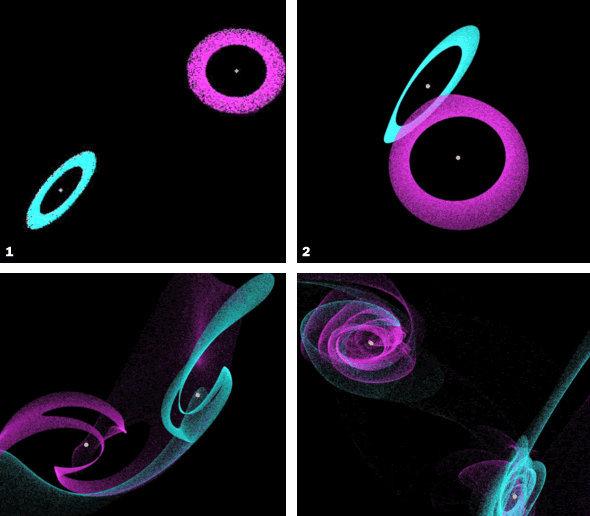
The image above simulates two stars that interact closely and produce a material exchange, each surrounded by planets and other matter (Source: S. Kenyon, CfA)
Astronomers believe that the outer edge of the solar system may have been affected a long time ago by close contact with another star that tore apart two newborn planetary systems like a chainsaw.
If this dramatic encounter does happen, there may be a different world between us.
Relying on speculation about real events, the purpose of this hypothesis is to describe unexplained celestial observations. Computer simulations suggest that about 4.5 billion years ago, shortly after the formation of the planet, a neighboring object appeared, and the two met to produce a series of results.
Scott Kenyan of the Smithsonian Astrophysical Observatory said: "It is possible that some of the material in the solar system originally orbited another star."
Early Chaos
There is no conclusive evidence that the Sun ever interacted closely with another star, but many astronomers believe that the Sun was likely born in a dense cluster of stars, all of which formed from the same cloud of gas. Most stars in the galaxy were born this way, and the Sun, which is thought to have been expelled from the galaxy cluster later.
Scientists have said that in the early chaos, when planets, comets and asteroids were still forming, the sun may have moved too close to another star.
Several studies have used this interaction to explain the structure of the solar system or to reason about how planets develop.
New computer models show that the orbits of young planet-sized objects that orbit the Sun may be elongated by gravity, forcing the body to move away from the Sun and thus out of sight. This interaction could also lead to a sharp decrease in the number of objects detected at the outer edge of the Kuiper Belt, a region of icy material outside Neptune.
The study was published in the Dec. 2 issue of the journal Nature.
In 2003, the asteroid Sedna was discovered, a celestial body far beyond Neptune, and one of the purposes of the model was to explain Sedna's existence. Outside Neptune, Sedna is at least half the size of Pluto, and its orbit is very slender, completely outside the Kuiper Belt.
Astronomers don't know exactly why Sedna's orbit took shape, but they suspect it's much more than that.
Ken Young and his colleague, Benjamin Bromley of the University of Utah, provided some data. They believe that the sun had a collision at least 30 million years old and no more than 200 million years ago. Distances of 14 billion to 19 billion miles (22.5-3.05 billion kilometers) could disrupt the outer Kuiper Belt without altering the orbits of the inner planets.
Substance exchange
When a star passes by, it will take some space rocks out of the solar system, and it will also push some ice rocks and planet-like objects into the solar system.
Bromley said: "The close-up stars solve two puzzles, namely Sedna's orbit and the outer edge of the Kuiper Belt."
Mike Brown, an astronomer from caltech who explored Sedna, says there are many other ways to explain Sedna's plight. The new study could effectively answer why Sedna went into an extremely narrow orbit, but that's certainly not the only answer. The mystery of Sedna's orbit is far from solved. It is also possible that Sedna was pushed into her current orbit by an Earth-sized planet that is no longer in the Kuiper Belt or by some other factor.
Brown also believes that in order to better advance research, it is not enough to explore one object alone, and we should also look for more similar objects to detect.
Related knowledge
The Solar System is a planetary system bound together by the Sun's gravity, including the Sun and celestial bodies that orbit it directly or indirectly.[a] Of the bodies that orbit the Sun directly, the largest eight are called planets,[b] and the rest are much smaller than planets, such as dwarf planets, solar system asteroids, and comets. The objects orbiting the Sun indirectly are moons, two of which are larger than the smallest planet, Mercury.
The formation of the solar system began about 4.6 billion years ago with the gravitational collapse of a giant interstellar molecular cloud. Most of the mass in the solar system is concentrated in the Sun, and the most massive of the remaining celestial bodies is Jupiter. Located in the inner solar system are four smaller planets, Mercury, Venus, Earth, and Mars, known as terrestrial planets and made up mostly of rock and metal. The four outer planets are called giant planets, and their masses are much larger than those of terrestrial planets. The two largest of these are Jupiter and Saturn, both gas giants whose main components are hydrogen and helium. The two outermost planets are Uranus and Neptune, ice giants that are mainly composed of volatile components with higher melting points than hydrogen and helium, such as water, ammonia and methane. Almost all planets orbit in circular orbits close to the plane of the ecliptic.
BY: Robert Roy Britt
FY: Busy North Gate
If there is any infringement of the relevant content, please contact the author to delete it after the work is published
Please also obtain authorization to reprint, and pay attention to maintaining completeness and indicating source